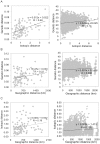Dietary differentiation and the evolution of population genetic structure in a highly mobile carnivore
- PMID: 22768075
- PMCID: PMC3387138
- DOI: 10.1371/journal.pone.0039341
Dietary differentiation and the evolution of population genetic structure in a highly mobile carnivore
Abstract
Recent studies on highly mobile carnivores revealed cryptic population genetic structures correlated to transitions in habitat types and prey species composition. This led to the hypothesis that natal-habitat-biased dispersal may be responsible for generating population genetic structure. However, direct evidence for the concordant ecological and genetic differentiation between populations of highly mobile mammals is rare. To address this we analyzed stable isotope profiles (δ(13)C and δ(15)N values) for Eastern European wolves (Canis lupus) as a quantifiable proxy measure of diet for individuals that had been genotyped in an earlier study (showing cryptic genetic structure), to provide a quantitative assessment of the relationship between individual foraging behavior and genotype. We found a significant correlation between genetic distances and dietary differentiation (explaining 46% of the variation) in both the marginal test and crucially, when geographic distance was accounted for as a co-variable. These results, interpreted in the context of other possible mechanisms such as allopatry and isolation by distance, reinforce earlier studies suggesting that diet and associated habitat choice are influencing the structuring of populations in highly mobile carnivores.
Conflict of interest statement
Figures



Similar articles
-
Ecological factors influence population genetic structure of European grey wolves.Mol Ecol. 2006 Dec;15(14):4533-53. doi: 10.1111/j.1365-294X.2006.03110.x. Mol Ecol. 2006. PMID: 17107481
-
Intrapopulation variation in gray wolf isotope (delta(15)N and delta(13)C) profiles: implications for the ecology of individuals.Oecologia. 2005 Sep;145(2):317-26. doi: 10.1007/s00442-005-0124-2. Epub 2005 Oct 25. Oecologia. 2005. PMID: 15883848
-
Dynamic range expansion leads to establishment of a new, genetically distinct wolf population in Central Europe.Sci Rep. 2019 Dec 12;9(1):19003. doi: 10.1038/s41598-019-55273-w. Sci Rep. 2019. PMID: 31831858 Free PMC article.
-
Discrimination factors of carbon and nitrogen stable isotopes from diet to hair in captive large Arctic carnivores of conservation concern.Rapid Commun Mass Spectrom. 2018 Oct 30;32(20):1773-1780. doi: 10.1002/rcm.8239. Rapid Commun Mass Spectrom. 2018. PMID: 30030922
-
Differentiation of tundra/taiga and boreal coniferous forest wolves: genetics, coat colour and association with migratory caribou.Mol Ecol. 2007 Oct;16(19):4149-70. doi: 10.1111/j.1365-294X.2007.03458.x. Epub 2007 Aug 23. Mol Ecol. 2007. PMID: 17725575
Cited by
-
Ecological opportunities and specializations shaped genetic divergence in a highly mobile marine top predator.Proc Biol Sci. 2014 Nov 22;281(1795):20141558. doi: 10.1098/rspb.2014.1558. Proc Biol Sci. 2014. PMID: 25297864 Free PMC article.
-
Chromosomal Inversion Associated With Diet Differences in Common Quails Sharing Wintering Grounds.Ecol Evol. 2025 Aug 20;15(8):e71792. doi: 10.1002/ece3.71792. eCollection 2025 Aug. Ecol Evol. 2025. PMID: 40843030 Free PMC article.
-
The host age related occurrence of Alaria alata in wild canids in Latvia.Parasitol Res. 2018 Dec;117(12):3743-3751. doi: 10.1007/s00436-018-6074-5. Epub 2018 Sep 14. Parasitol Res. 2018. PMID: 30218314
-
Population genetic structure of wolves in the northwestern Dinaric-Balkan region.Ecol Evol. 2021 Dec 12;11(24):18492-18504. doi: 10.1002/ece3.8444. eCollection 2021 Dec. Ecol Evol. 2021. PMID: 35003687 Free PMC article.
-
Large-scale genetic structuring of a widely distributed carnivore--the Eurasian lynx (Lynx lynx).PLoS One. 2014 Apr 2;9(4):e93675. doi: 10.1371/journal.pone.0093675. eCollection 2014. PLoS One. 2014. PMID: 24695745 Free PMC article.
References
-
- Rueness EK, Stenseth NC, O’Donoghue M, Boutin S, Ellegren H, Jakobsen KS. Ecological and genetic spatial structuring in the Canadian lynx. Nature. 2003;425:69–72. - PubMed
-
- Geffen E, Anderson MJ, Wayne RK. Climate and habitat barriers to dispersal in the highly mobile grey wolf. Mol Ecol. 2004;13:2481–2490. - PubMed
-
- Dalén L, Fuglei E, Hersteinsson P, Kapel CMO, Roth JD, et al. Population history and genetic structure of a circumpolar species: the arctic fox. Biol J Linn Soc. 2005;84:79–89.
-
- Sacks BN, Mitchell BR, Williams CR, Ernest HB. Coyote movements and social structure along a cryptic population genetic subdivision. Mol Ecol. 2005;14:1241–1249. - PubMed
Publication types
MeSH terms
Substances
LinkOut - more resources
Full Text Sources

